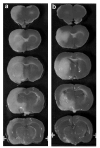Neuroprotection by neuregulin-1 in a rat model of permanent focal cerebral ischemia
- PMID: 17961519
- PMCID: PMC2374743
- DOI: 10.1016/j.brainres.2007.09.037
Neuroprotection by neuregulin-1 in a rat model of permanent focal cerebral ischemia
Erratum in
- Brain Res. 2008 Oct 10;1229:249
Abstract
Neuregulin-1 (NRG-1) is a growth factor with potent neuroprotective capacity in ischemic stroke. We recently showed that NRG-1 reduced neuronal death following transient middle cerebral artery occlusion (tMCAO) by up to 90% with an extended therapeutic window. Here, we examined the neuroprotective potential of NRG-1 using a permanent MCAO ischemia (pMCAO) rat model. NRG-1 reduced infarction in pMCAO by 50% when administered prior to ischemia. We previously demonstrated using gene expression profiling that pMCAO was associated with an exaggerated excitotoxicity response compared to tMCAO. Therefore, we examined whether co-treatment with an inhibitor of excitotoxicity would augment the effect of NRG-1 following pMCAO. Both NRG-1 and the N-methyl-D-aspartate (NMDA) antagonist MK-801 similarly reduced infarct size following pMCAO. However, combination treatment with both NRG-1 and MK-801 resulted in greater neuroprotection than either compound alone, including a 75% reduction in cortical infarction compared to control. Consistent with these findings, NRG-1 reduced neuronal death using an in vitro ischemia model and this effect was augmented by MK-801. These results demonstrate the efficacy of NRG-1 in pMCAO rat focal ischemia model. Our findings further indicate the potential clinically relevance of NRG-1 alone or as a combination strategy for treating ischemic stroke.
Figures





Similar articles
-
Spatio-temporal assessment of the neuroprotective effects of neuregulin-1 on ischemic stroke lesions using MRI.J Neurol Sci. 2015 Oct 15;357(1-2):28-34. doi: 10.1016/j.jns.2015.06.055. Epub 2015 Jun 27. J Neurol Sci. 2015. PMID: 26183085 Free PMC article.
-
Evaluation of neuregulin-1's neuroprotection against ischemic injury in rats using diffusion tensor imaging.Magn Reson Imaging. 2018 Nov;53:63-70. doi: 10.1016/j.mri.2018.07.002. Epub 2018 Jul 21. Magn Reson Imaging. 2018. PMID: 30021123
-
Neuroprotection by neuregulin-1 following focal stroke is associated with the attenuation of ischemia-induced pro-inflammatory and stress gene expression.Neurobiol Dis. 2005 Aug;19(3):461-70. doi: 10.1016/j.nbd.2005.01.027. Neurobiol Dis. 2005. PMID: 16023588
-
Neuroprotection by Exogenous and Endogenous Neuregulin-1 in Mouse Models of Focal Ischemic Stroke.J Mol Neurosci. 2019 Oct;69(2):333-342. doi: 10.1007/s12031-019-01362-4. Epub 2019 Jul 9. J Mol Neurosci. 2019. PMID: 31290093
-
Extended therapeutic window and functional recovery after intraarterial administration of neuregulin-1 after focal ischemic stroke.J Cereb Blood Flow Metab. 2006 Apr;26(4):527-35. doi: 10.1038/sj.jcbfm.9600212. J Cereb Blood Flow Metab. 2006. PMID: 16136057
Cited by
-
Microenvironmental regulation of oligodendrocyte replacement and remyelination in spinal cord injury.J Physiol. 2016 Jul 1;594(13):3539-52. doi: 10.1113/JP270895. Epub 2016 Mar 29. J Physiol. 2016. PMID: 26857216 Free PMC article. Review.
-
An optimized dosing regimen of cimaglermin (neuregulin 1β3, glial growth factor 2) enhances molecular markers of neuroplasticity and functional recovery after permanent ischemic stroke in rats.J Neurosci Res. 2016 Mar;94(3):253-65. doi: 10.1002/jnr.23699. Epub 2015 Dec 11. J Neurosci Res. 2016. PMID: 26660233 Free PMC article. Clinical Trial.
-
The case for neuregulin-1 as a clinical treatment for stroke.Front Cell Neurosci. 2024 Apr 4;18:1325630. doi: 10.3389/fncel.2024.1325630. eCollection 2024. Front Cell Neurosci. 2024. PMID: 38638304 Free PMC article. Review.
-
Expression of ErbB4 in the apoptotic neurons of Alzheimer's disease brain.Anat Cell Biol. 2010 Dec;43(4):332-9. doi: 10.5115/acb.2010.43.4.332. Epub 2010 Dec 31. Anat Cell Biol. 2010. PMID: 21267408 Free PMC article.
-
Neuregulin 1/ErbB4 signaling attenuates neuronal cell damage under oxygen-glucose deprivation in primary hippocampal neurons.Anat Cell Biol. 2019 Dec;52(4):462-468. doi: 10.5115/acb.19.210. Epub 2019 Dec 31. Anat Cell Biol. 2019. PMID: 31949986 Free PMC article.
References
-
- Andrews RJ. Neuroprotection for the new millennium. Matchmaking pharmacology and technology. Ann N Y Acad Sci. 2001;939:114–25. - PubMed
-
- Aronowski J, Strong R, Shirzadi A, Grotta JC. Ethanol plus caffeine (caffeinol) for treatment of ischemic stroke: preclinical experience. Stroke. 2003;34:1246–51. - PubMed
-
- Aspey BS, Alp MS, Patel Y, Harrison MJ. Effects of combined glutamate and platelet-activating factor inhibition on the outcome of focal cerebral ischaemia - an initial screening study. Metab Brain Dis. 1997;12:237–49. - PubMed
-
- Barone FC, Feuerstein GZ. Inflammatory mediators and stroke: new opportunities for novel therapeutics. J Cereb Blood Flow Metab. 1999;19:819–34. - PubMed
-
- Belayev L, Khoutorova L, Zhang Y, Belayev A, Zhao W, Busto R, Ginsberg MD. Caffeinol confers cortical but not subcortical neuroprotection after transient focal cerebral ischemia in rats. Brain Res. 2004;1008:278–83. - PubMed
Publication types
MeSH terms
Substances
Grants and funding
LinkOut - more resources
Full Text Sources
Other Literature Sources

